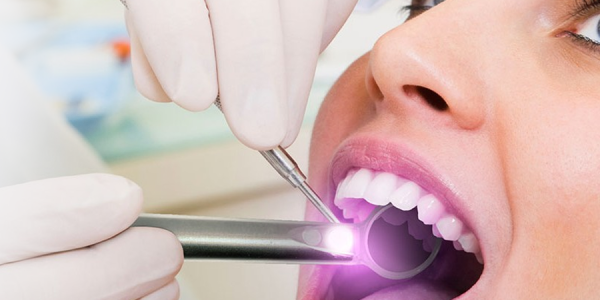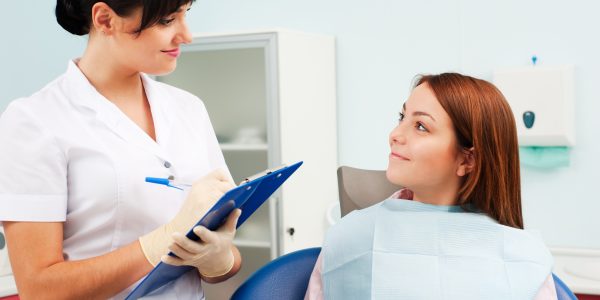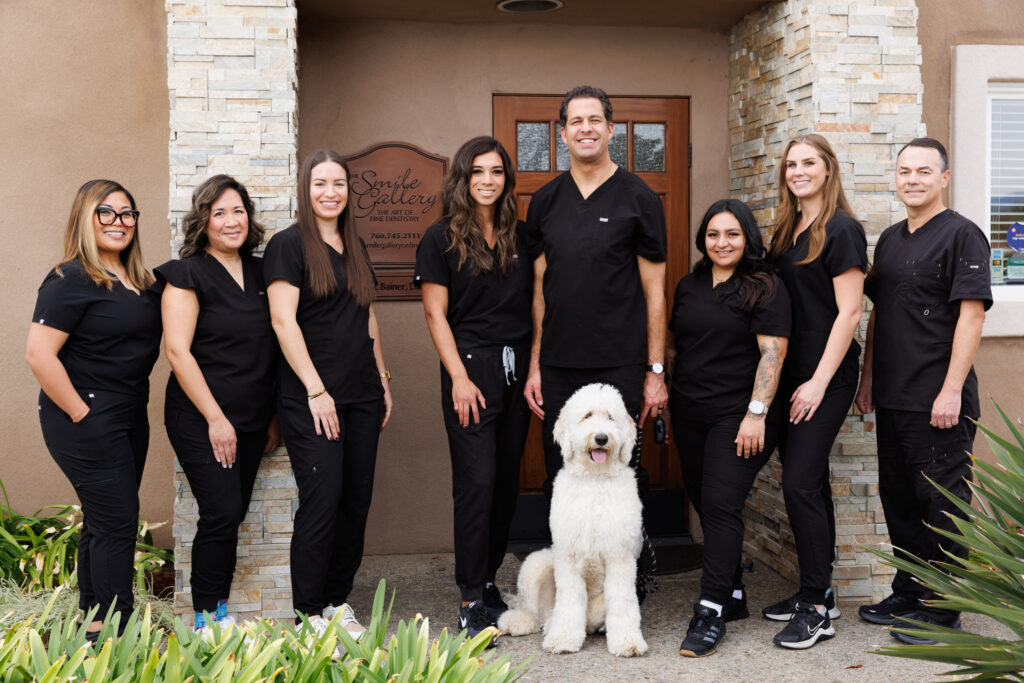Oral Cancer Screening
Dentists often recommend screenings in response to patients’ lifestyle choices, but some patients ask for them out of an abundance of caution. Read on to learn more about the oral cancer screening services your Escondido Dentist, Dr. Bainer, provides.
Oral Cancer Screening – Visual Exam
The lips, neck, face, oral cavity, and inside of the nose are all included in oral cancer screenings. Before the screening begins, the patient is asked to remove dentures, a retainer, or other appliances.
Whether the patient is lying down or sitting up, the dentist will look for swelling, asymmetry, oddly-colored patches, bumps, ulcers, and other abnormalities. To see inside the mouth and nose, the dentist will use a mirror and a light; to see into the back of the mouth, a tongue depressor is used. Other dental tools may help the doctor evaluate the inner cheeks, gums, top of the mouth, throat, tonsils, and under the tongue.
The Smile Gallery Patient Reviews
The Physical Exam
During or after the visual exam, the dentist will touch the patient’s cheeks and head, the area around the jaw and under the chin, and the oral cavity in a search for unusual masses or nodes. The dentist will also look for immobility in tissues that are normally mobile, and he may ask the patient whether it hurts to touch the area. Oral cancer signs are often painful, but painless bumps can indicate problems in other areas.


Further oral cancer screenings should be done. In some instances, patients are referred to oral surgeons for consultations.
Oral Cancer Screening Guidelines
According to information from the US Preventive Services Task Force, there’s insufficient proof that screenings reduce the rate of oral cancer in adults with no symptoms. However, dentists and medical experts agree that, in practice, screenings will detect cancer at the earliest stages where it’s more treatable. For these reasons, the ADA provides these screening guidelines.
* Dentists should perform internal and external touch and visual exams in adult patients.
* If suspicious areas are detected, the dentist should do a biopsy immediately or refer the patient to an oral surgeon.
While oral cancer screenings can help anyone, it may be particularly important for those with risk factors such as:
* The usage of tobacco, including cigarettes, cigars, snuff, pipes, and chewing tobacco
* A previous diagnosis of oral cancer
* A history of sun exposure, which increases the risk of cancer of the lips
Consult Dr. Bainer to learn more about individual screening requirements and scheduling.
The Most Common Signs of Oral Cancer
Oral cancer has many signs, but the most common are gum sores, bleeding inside the mouth, inner cheek lesions that don’t heal within a week or two, and numbness of the throat or mouth. Patients who’ve received an oral cancer diagnosis may also experience white or red patches on the inner cheeks and gums, ear pain, and trouble swallowing. Some oral cancer sufferers note that their teeth don’t align correctly and their jaws don’t move properly. Many people have throat problems such as soreness or the feeling that something is stuck. The most important thing for patients to remember is that oral cancer signs don’t just affect the mouth.
Why An Oral Cancer Screening is Crucial
Oral cancer examinations are essential because of the hidden nature of the disease. Oral cancer causes more deaths than other, more well-known cancers, but it is highly treatable if it is caught early. Because the oral cancer screening process is so straightforward, simple, and pain-free, there’s no reason for patients to put it off, especially because it can potentially save lives. Even if a patient doesn’t believe they have any of the signs listed here, it is still wise to have an oral cancer exam once per year to ensure that problems don’t arise.
After the Oral Cancer Evaluation
Oral cancer screenings are a precautionary measure rather than a diagnostic tool. If the dentist finds no problems during the oral exam, he may ask the patient to come back at
scheduled intervals for additional screenings. A patient’s lifestyle choices, such as alcohol consumption, tobacco use, or drug use may increase his or her risk, and the dentist may make additional testing recommendations.
In some cases, the dentist may refer the patient for additional testing to learn the reasons behind certain symptoms. Patients should remember that a result that requires further investigation is not the same thing as a positive diagnosis. Even if a person has oral cancer, the ADA (American Dental Association) says that early detection reduces treatment-related health issues later in life.
Call Today, Don’t Delay
Oral cancer screenings aren’t just routine medical exams; they’re an opportunity for patients to talk to the dentist about their concerns and fears, and to ask for tips on reducing the risk of cancer. If a patient is nervous about the screening, we’re here to help. Call today to schedule a consultation or book an appointment online.

Our Promise to You
The Smile Gallery practices the Art of Fine Dentistry. We work to ensure our patients have the most relaxed and comfortable experience possible. Our individualized patient attention means you receive the best care possible. Our friendly staff is ready to greet you warmly, set you at ease, and create a level of comfort and customer service rarely seen in the dental industry.
We understand patients who have dental anxiety and have been working for years to provide the safe, comfortable environment that makes you want to see your Escondido dentist a few times a year or anytime your teeth need dental services.
